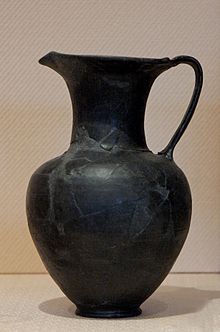Bucchero

Bucchero [ ˈbukkero ] ( Italian , originally from Portuguese bucáro "fragrant clay") is a genus of black, externally shiny clay vessels , which from the middle of the 7th century to the beginning of the 4th century BC. Were producedby the Etruscans . At the beginning (up to 600 BC) thin-walled vessels, often decorated with incised decorations, the so-called Bucchero sottile , were created, which were supposed to imitate metal vessels with their shape and shine. In the 6th century BC The coarser Bucchero pesante followed , which was often decorated with modeled jewelry and stamp reliefs.
The Italian word "Bucchero" is derived from the Portuguese word "bucáro", which the conquerors of South America used to describe the black and gray ceramics found there . Towards the end of the 19th century, the word was borrowed into Italian, where it became a synonym for "gray-black" as the name for dark dishes imported from Portugal . Modern archeology has adopted this name for the typical Etruscan ceramics.
The black, shiny color results from a fire in the so-called reducing fire. The oxygen supply is stopped by narrowing the exhaust air openings and adding fuel, which creates deep black iron oxide.
The Etruscan Bucchero was found on the Gallic-Iberian coast, in Carthage , Magna Graecia , Greece , Lower Egypt, as well as in Sardinia , Sicily and Cyprus . In addition, in the Aeolian- populated northern Ionia, v. a. on the island of Lemnos with its most important polis Mytilene and on Lesbos in the 7th and early 6th centuries BC An Aeolian Bucchero, which is characterized by a simple, pale-gray style.
literature
- Bernard Bouloumié: Le bucchero nero d'Etrurie. In: Latomus 41, 1982, ISSN 0023-8856 , pp. 773-784.
- Nancy Hirschland-Ramage: Studies in Early Etruscan Bucchero. In: Papers of the British School at Rome 38, 1970, ISSN 0068-2462 , pp. 1-61.
- Delia Lollini: Bucchero. In: Enciclopedia dell'Arte Antica, Classica e Orientale . Volume 2: Bas-Dam. Istituto della Enciclopedia Italiana, Rome 1959, Sp. 203-210 digitized .
- Marina Martelli: Bucchero. In: Enciclopedia dell'arte antica classica e orientale. II Supplemento. Istituto della Enciclopedia Italiana, Rome 1994 Digitized
- Tom B. Rasmussen: Bucchero pottery from Southern Etruria. Cambridge University Press, Cambridge et al. 1979. ISBN 0-521-22316-4 .